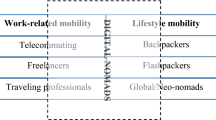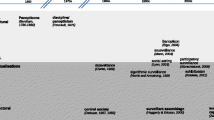Abstract
This study attempts to focus on how the boundaries of both the private and the public domain are lived out in people's practices of taking mobile snapshots via camera phones and sharing them on the Web. From private photo-taking practices in public places to online disclosure of camera phone pictures, private/public boundaries are no longer firmly fixed. Based on qualitative interview data collected from 20 Korean camera phone users in their early twenties, this study takes a closer look at how private/public boundaries are blurred or rearranged in people's everyday camera phone usage in a public space, as well as in their sharing of camera phone photos on the Web. By examining the concrete cases of “displaced moments” captured by camera phones and their circulation on the Web as a form of self-presentation, it discusses how mobile snapshots have served as a medium that is shaping the dynamic reconfiguration of private/public boundaries.
Similar content being viewed by others
References
boyd D (2008) Why youth ♥ social network sites. In: Buckingham D (ed) Youth, identity, and digital Media. The MIT Press, Cambridge, MA, pp 119-142
Chalfen R (1987) Snapshot versions of life. Bowling Green State University Popular Press, Bowling Green, Ohio
Cooper G (2002) The mutable mobile: Social theory in the wireless world. In: Brown B, Green N, Harper R. (eds) Wireless world: Social and interactional aspects of the mobile age. Springer, London, pp 19-31
Fortunati L (2002) The mobile phone: Towards new categories and social relations. Information, Communication & Society 5(4): 513-528
Goffman E (1959) The presentation of self in everyday life. Doubleday, New York
Gumpert G, Drucker S (2007) Mobile communication in the 21st century or "everybody, everywhere, at any time.” In: Kleinman S (ed) Displacing place. Peter Lang, New York, pp 7-20
Gye L (2007) Picture this: The impact of mobile camera phones on personal photographic practices. Continuum 21(2): 279-288
Hjorth L (2007) Snapshots of almost contact: The rise of camera phone practices and a case study in Seoul, Korea. Continuum 21(2): 227-238
Höflich J (2006) The mobile phone and the dynamic between private and public communication: Results of an international exploratory study. Knowledge, Technology & Policy 19(2): 58-68
Ito M (2005) Intimate visual co-presence. Paper presented at UbiComp 2005. Available via http://www.itofisher.com/mito/archives/ito.ubicomp05.pdf. Accessed 15 Jan 2009
Jimroglou K (2001) A camera with a view: JennieCAM, visual representations and cyborg subjectivity. In: Green E, Adam A (eds) Virtual gender: Technology, consumption and identity. Routledge, London, pp 286-301
Kang D (2004, February 18) Motizen pilsupum(Necessaries for motizens). Digital Times. Available via http://news.naver.com/main/read.nhn?mode=LSD&mid=sec&sid1=105&oid=029&aid=0000057928. Accessed 20 Feb 2009
Kindberg T, Spasojevic M, Fleck R, Sellen A (2005) The ubiquitous camera: An in-depth study of camera phone use. IEEE Pervasive Computing 4(2): 42-50
Kopomaa T (2004) Speaking mobile: Intensified everyday life, condensed city. In: Graham S (ed) Cybercities reader. Routledge, London, pp 267-272.
Koskela H (2004) Webcams, TV shows and mobile phones: Empowering exhibitionism. Surveillance and Society 2(2/3): 199-215
Koskinen I (2005) Seeing with mobile images: Towards perpetual visual contact. In: Nyiri K (ed) A sense of place: The global and the local in mobile communication. Passagen Verla, Vienna, pp 339-347
Lange P (2008) Publicly private and privately public: Social networking on YouTube. Journal of Computer-Mediated Communication 13: 361-380
Lee, D-H (2005) Women's creation of camera phone culture. Fibreculture 6. Available via http://journal.fibreculture.org/issue6/issue6_donghoo.html. Accessed 1 Mar 2006
Ling R, Julsrud T (2005) Grounded genres in multimedia messaging. In: Nyiri K (ed) A sense of place: The global and the local in mobile communication. Passagen Verla, Vienna, pp 329 - 338
Livingstone S (2008) Taking risky opportunities in youthful content creation: Teenagers' use of social networking sites for intimacy, privacy and self-expression. New Media & Society 10(3): 393~411
Marx G (2001) Murky conceptual waters: The public and the private. Ethics and Information Technology 3(3): 157-169
Moores S (2004) The doubling of place: Electronic media, time-space arrangement and social relationships. In: Couldry N, McCarthy A (eds) Mediaspace: Place, scale and culture in a media age. Routledge, London, pp 21-36
Okabe D, Ito M (2006) Everyday contexts of camera phone use: Steps toward technosocial ethnographic frameworks. In: Höflich J, Hartmann M (eds) Mobile communication in everyday life: An ethnographic view. Frank & Timme, Berlin, pp 79-102
Rantavuo H (2009) Connecting photos: A qualitative study of cameraphone photo use. University of Art and Design in Helsinki, Helsinki
Shapiro S (1998) Places and spaces: The historical interaction of technology, home, and privacy. The Information Society 14: 275-284
Van House N, Davis M, Ames M, Finn M, Viswanathan V (2005) The uses of personal networked digital imaging: An empirical study of cameraphone photos and sharing. Presented at CHI 2005. Available via http://people.ischool.berkeley.edu/~vanhouse/van_house_chi_short.pdf. Accessed 15 Jan 2009
Weintraub J (1997) The theory and politics of public/private distinction. In: Weintraub J, Kumar K (eds) Public and private in thought and practice. University of Chicago, Chicago, pp 1-42
White M (2006) The body and the screen: Theories of Internet spectatorship, The MIT Press, Cambridge, MA
Williams R (1974) Television: Technology and cultural form. Fontana, London
Acknowledgement
This work was supported by the University of Incheon Research Grant in 2008.
Author information
Authors and Affiliations
Corresponding author
Rights and permissions
About this article
Cite this article
Lee, DH. Mobile Snapshots and Private/Public Boundaries. Know Techn Pol 22, 161–171 (2009). https://doi.org/10.1007/s12130-009-9081-0
Received:
Accepted:
Published:
Issue Date:
DOI: https://doi.org/10.1007/s12130-009-9081-0




